Rail tank cars used to transport crude oil and many other flammable liquids will have to be built to stronger standards to reduce the risk of a catastrophic train crash and fire, under sweeping new safety rules unveiled by U.S. and Canadian transportation officials.
The regulations are a long-awaited response to a series of fiery train crashes in the U.S. and Canada, including four so far this year. The most serious accident occurred in July 2013, when a runaway oil train derailed in Lac-Megantic, Quebec, just across the border from Maine, killing 47 people and destroying most of the town’s central business district.
Under the rules, new tank cars carrying the most volatile liquids, including crude oil and ethanol, must have an outer shell, a thermal lining to withstand fire, improved valves and thicker, 9/16ths-inch steel walls to keep them from rupturing.
For the crude oil fleet, more than 16,000 of the oldest tank cars, known as DOT-111s, would have to be phased out or retrofitted in the U.S. and Canada by 2018. By 2020, an additional 27,000 cars primarily used for crude would need to be upgraded.
For the ethanol fleet, retrofits for almost 20,000 DOT-111s would have to be completed by May 2023. All remaining cars used to haul hazardous flammable liquids would need retrofits or replacement by 2025.
Defending the timetable, Foxx said officials took into account how long it will take manufacturers to produce tank cars to the new standard. “This is a schedule we believe is workable; it’s aggressive,” he said. “If you talk to some of the manufacturers who are going to have to do the work, it’s more aggressive than they would like.”








